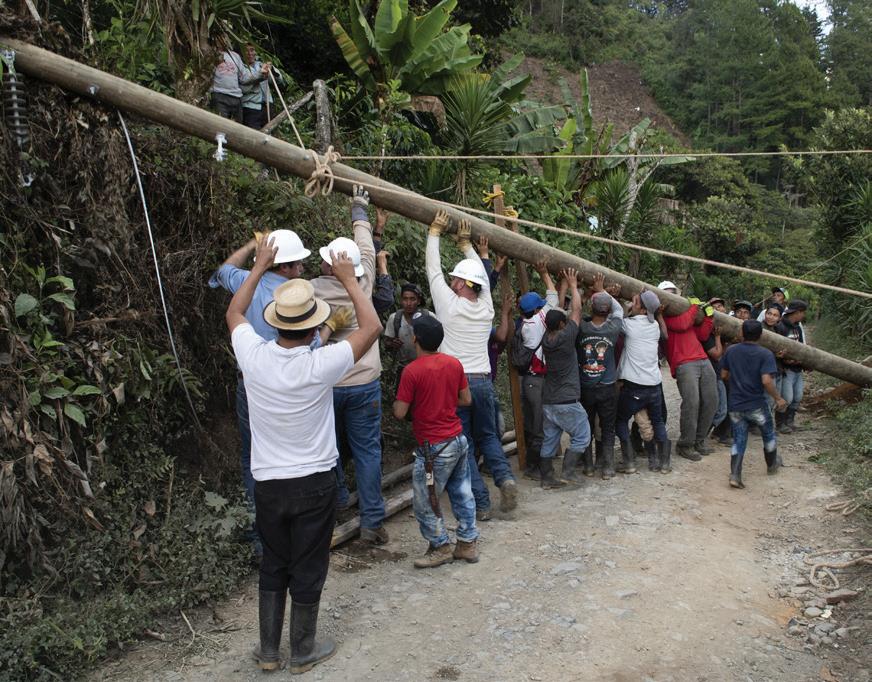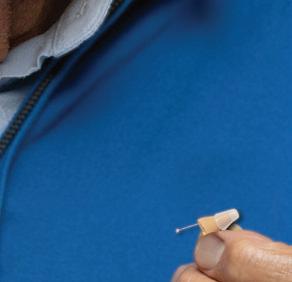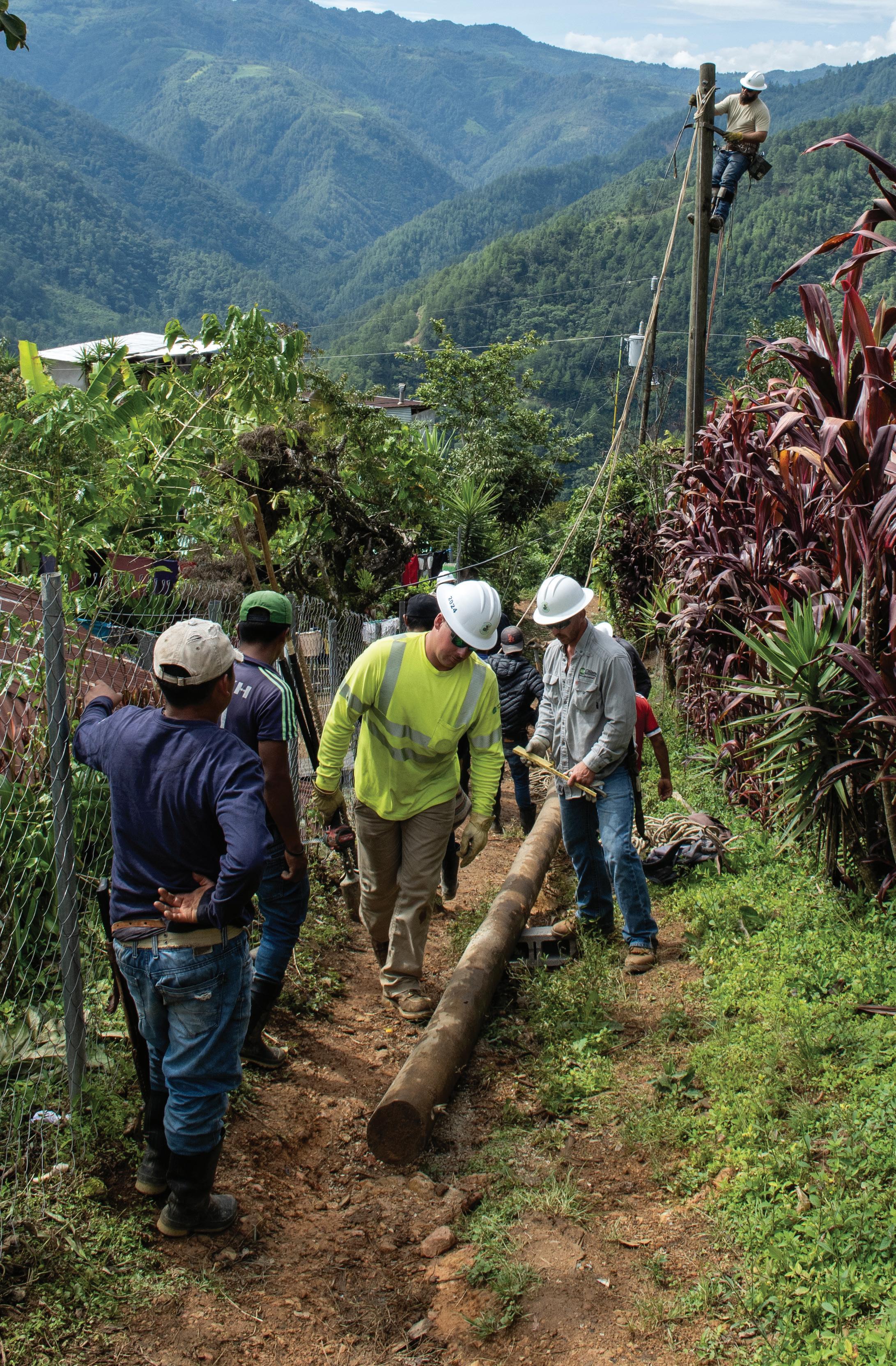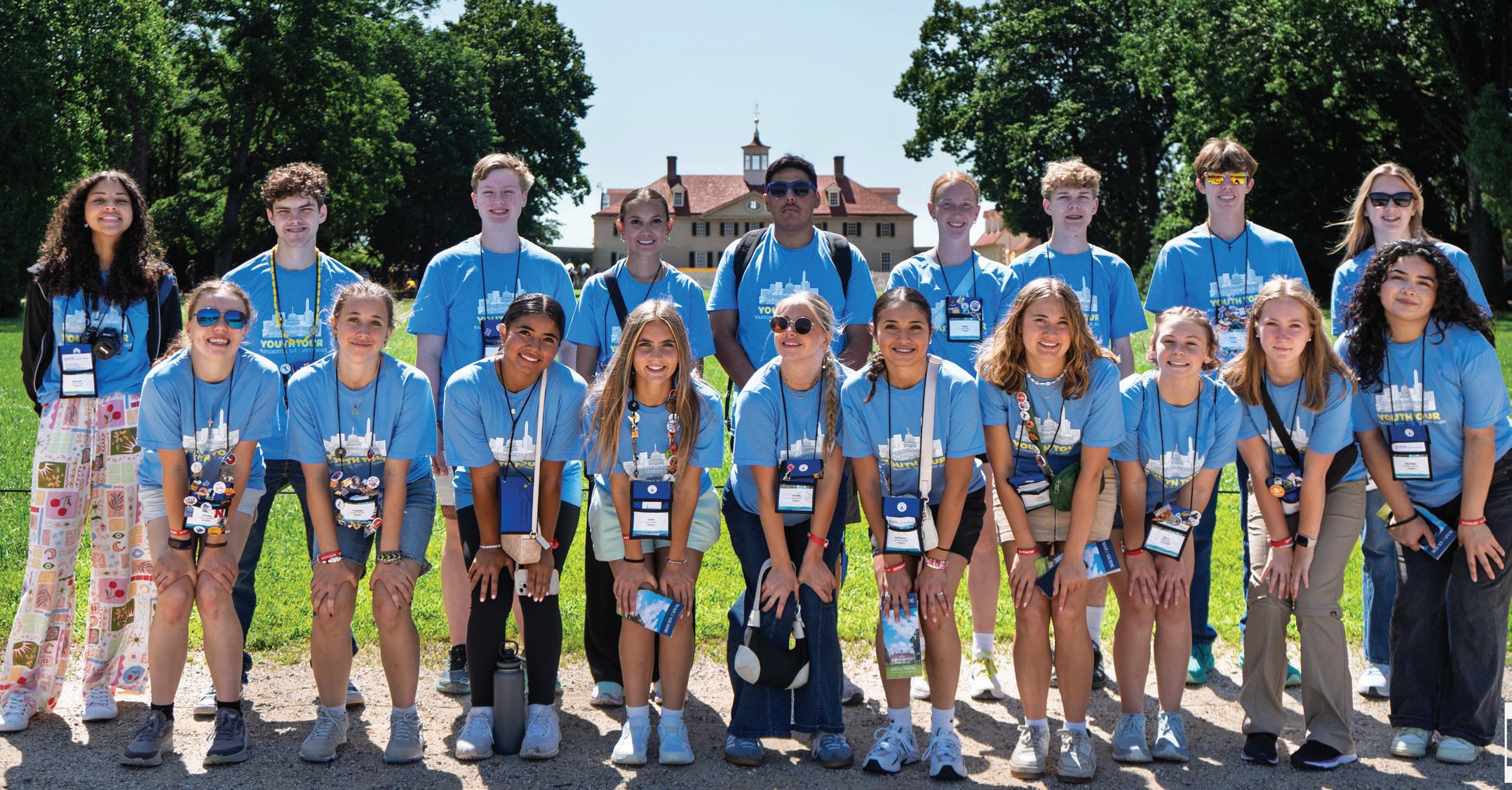Ruralite
CENTRAL ELECTRIC
OCTOBER 2025

When Fire Meets the Electric Grid Page 4
New Electricity Rates Take Effect Page 32
Teen Shares Youth Tour Experience Page 32




































CENTRAL ELECTRIC
OCTOBER 2025

When Fire Meets the Electric Grid Page 4
New Electricity Rates Take Effect Page 32
Teen Shares Youth Tour Experience Page 32



































October 2025 • Volume 72, No. 10
CEO Michael Shepard
SENIOR VP OF CONTENT Leon Espinoza
EDITORIAL DIRECTOR Chasity Anderson, CCC
DEPUTY EDITORIAL DIRECTOR
Noble Sprayberry
SENIOR EDITOR Jennifer Paton, CCC
ASSISTANT EDITORS Victoria Hampton, CCC; David Herder, CCC; Sable Riley, CCC
ASSOCIATE EDITORS
Valeri Saldanha Rosa, Nina Todea, CCC
PUBLICATIONS PRODUCTION SR. MANAGER
Elizabeth Beatty
SENIOR PUBLICATIONS COORDINATOR
Alyssa McDougle
Ruralite (USPS 397-460) is published monthly for members for $5.73 per year, plus postage, by Pioneer Utility Resources Inc., 5625 NE Elam Young Parkway, Suite 100, Hillsboro, OR 97124—a not-for-profit Oregon cooperative corporation—to serve the communication needs of 46 consumer-owned electric utilities in Oregon, Washington, Alaska, Idaho, Nevada and California. Preferred periodical postage paid at Hillsboro, Oregon, 97123 and additional mailing offices. © 2025 Pioneer Utility Resources. All rights reserved. Reproduction in whole or in part without written permission is prohibited.
Postmaster: Send address changes to Ruralite, 5625 NE Elam Young Parkway, Suite 100, Hillsboro, OR 97124-6454
HOW TO CONTACT RURALITE
Subscription services:
Nonmember subscriptions $15 (U.S.) per year; $25 per year (foreign). Prepayment required. Allow 4-8 weeks for first issue. Be sure to identify which local edition you want to receive.
Address Changes:
Utility members, contact your local utility. Subscribers, call us at 503-357-2105, option 3, or email mailingdept@pioneer.coop.
Back issues:
Back issues and extra copies are $3. Prepayment required. Supply is limited. Be sure to identify edition, month and year. Call first if ordering back issues to check availability.
To contact Ruralite: Ruralite magazine is published by Pioneer Utility Resources, P.O. Box 1306, North Plains, OR 97133-1306; 503-357-2105; email: info@pioneer.coop. For more information, visit pioneer.coop.
DISPLAY ADVERTISING INQUIRIES
American MainStreet Publications
611 S. Congress Ave., Suite 504 Austin, TX 78704 800-626-1181 or 512-441-5200

For supplemental and interactive content, search @Ruralite on your favorite social media sites.
This month’s cover story about Light Up Navajo and NRECA International demonstrates the power of utilities working together.
In May, when Lucille Williams woke to the sound of trucks outside her home, it marked the end of a 21-year wait for electricity.
“My heart was beating like crazy,” she tells us about the moment her porch light finally came on. “I was so anxious. I couldn’t wait.”
That moment represents more than just flipping a switch—it’s the result of lineworkers from across the country spending their time and expertise helping families they’d never met, in places they’d never been.
Likewise, for more than 60 years, NRECA International has been establishing electric utilities and cooperatives in 54 countries, bringing electricity to more than 220 million people worldwide. Their work goes beyond poles and wires—they engage communities in every step, from establishing utilities to training local people to maintain the systems long after crews return home.
“It’s not just about the lineworkers going there and establishing that service,” says Ingrid Hunsicker from NRECA International. “It is also making sure that the people within that community are prepared to maintain it moving forward.”
On a separate front, I have exciting news about our editorial team. We recently received four awards from the National Electric Cooperative’s Statewide Editors Association, including top honors for Victoria Hampton’s powerful feature “Giving a Voice to the Silent” about human trafficking and recognition for her

profile “Keeping Time” about a runner’s recovery from brain surgery. The two other awards were for photos used within features.
These awards recognize the heart of our team in every story. They also reflect our commitment to shining light in dark places and celebrating resilience in our communities.
As we celebrate National Co-op Month and Public Power Week, I’m reminded cooperation isn’t just about formal partnerships among organizations. It’s about recognizing our individual lights shine brightest when they’re connected to something larger—a power grid, a community gathering around a breakfast table or a magazine that carries stories from one reader to another.
Until next time, Chasity Anderson Editorial Director

Public power utilities band together for multiyear effort to bring electricity to thousands of families
Spotlight, Page 10
In the Kitchen, Page 16


By Brent ten Pas
Central Electric Cooperative Lineworker Zach Irzyk watched an ominous, growing cloud of smoke rise in the distance from the co-op’s utility yard on a late Friday afternoon in August. On call for the weekend, the third-generation lineworker knew what it might mean.
“I figured it was the calm before the storm, so I stocked up my truck,” he says, before spending the next two days continually balancing fire-related efforts with member outages.
The massive smoke column originated from the Flat Fire, which had ignited the previous day, Thursday, Aug. 21, 7 miles west of Culver. It was a typical high-desert summer day, absent the forecasted high winds.
The cooperative was already experiencing a busy wildfire season. Multiple fires had charred tens of thousands of acres throughout the summer within its expansive 5,300-square-mile service territory, threatening CEC’s electric infrastructure.
As part of its wildfire mitigation efforts, CEC had put its equipment on enhanced safety settings in early June throughout its high wildfire risk service territory. The settings prevent power lines from reenergizing if an object—a branch, tree or small animal—comes into contact. This helps prevent the ignition of a fire.
CEC personnel used internal and external resources to monitor the wildfire’s progress Thursday night, preparing to execute a plan if the fire encroached on the utility’s infrastructure. While the wildfire grew from 3,300 to 5,000 acres overnight, it was still miles away from the co-op’s closest infrastructure.
Friday morning, Chris Jones—crew foreman and a 19-year CEC veteran who has witnessed his share of firestorms—dispatched multiple teams to the Lower Bridge area near Crooked River Ranch, and to areas north of Sisters and Cloverdale. From their posts, they monitored weather and wind speeds while watching the Flat Fire’s progression.
The threat to the Lower Bridge area didn’t fully materialize. The nearly 3,500 acres burned in the Alder Springs Fire in June helped serve as a buffer, leaving the Flat Fire with little to no fuel.
Instead, the fire pushed southwest, consuming sagebrush, grasses and juniper trees in rugged terrain as it approached residential subdivisions miles north of Sisters, connected by Wilt Road, Buffalo Drive and Mountain View Road.
By Saturday afternoon, more than 600 co-op members were without power due to tripped safety
reclosers, fire-mandated line shutdowns or equipment destroyed by the fire.
Throughout the weekend, CEC kept members informed through its website, social media and call service, while crews maintained communication with fire officials. Working in tandem helps ensure the safety of the general public and fire crews and, if possible, save structures. This is not always an easy task, as jurisdiction can shift depending on whether land is private, county, state or federal.
Then, there is often just waiting. Fire officials ultimately decide when the cooperative’s crews should deenergize or reenergize a power line or gain access to inspect the electric grid to make repairs. Conditions change so rapidly that crews can deenergize a line and reenergize it later, only to return and shut it down again.
“We just have to wait until we get the go-ahead from the fire official to let us in there and see what we need to do,” Chris says. “We’re kind of limited on outage restoral time, but as soon as they give us the green light, we get in there and we get it fixed pretty fast.”
After crews received permission to inspect equipment and patrol lines in the affected areas, they spent Sunday replacing power poles and distribution lines.
By 3 p.m. Monday, CEC crews had restored power to all but six members, whose properties had equipment in need of repair or replacement.
For those members, outage lengths ranged from less than an hour to 20.5 hours, except for the six whose power was restored by late Wednesday.
To date, the recovery effort required replacing 12 power poles, ancillary equipment and 660 feet of overhead wire.
“Considering the size and scope and how quickly the fire got to our infrastructure, I am extremely grateful for the minimal damage that it incurred,” says CEC President and CEO Brad Wilson, who has served the co-op in various roles for nearly 28 years, including as a lineworker.
“The weekend also demonstrated what a great job CEC’s dispatch and line crews did in executing their jobs throughout a dangerous and volatile situation,” Brad says. “Their performance and dedication in serving our members were exemplary.”
At the time of this writing, the Flat Fire, approximately 2 miles northeast of Sisters, was 97% contained after burning an estimated 23,346 acres. n


By Jennah Denney and Nina Todea
Electric cooperatives and public power utilities across the country are urging members to stay alert as utility-related scams continue to evolve. Fraudsters are becoming more aggressive and more convincing— using impersonation, false urgency, and digital deception to extract payments or personal information from unsuspecting individuals.
Reports of scam calls, fake energy rebates and phony disconnection threats have increased recently. These schemes often begin with a phone call, text or even a visit from someone claiming to represent a local electric provider.
In 2024, impostor schemes—such as scammers pretending to be from utility companies—were the most commonly reported scam category, according to the Federal Trade Commission.
Their tactics vary, but the goal is always the same: pressure the consumer into acting quickly before they
have time to verify the request.
In some elaborate plans, scammers demand immediate payment, threatening that service will be shut off within minutes. Others offer too-good-to-betrue incentives, such as rebates, energy audits or free equipment installations—if the consumer provides banking information or pays an upfront fee.
Scammers can even manipulate caller ID to appear as though the call is coming from a trusted utility number.
Mt. Wheeler Power, based in Ely, Nevada, has—like many others—seen a rise in these scam attempts.
“The most common reports are phone calls threatening disconnection unless an immediate payment is made, but recently, a member shared a photo of a very official-looking letter claiming that her home warranty—supposedly managed by Mt. Wheeler—was about to expire,” says Christina Sawyer, Mt. Wheeler Power internal communications specialist. “Of course, we’re not in the home warranty business, but scammers used our name to try to solicit money.”

Scams aren’t limited to calls. They can arrive as emails, text messages or QR codes designed to look like real payment portals. Typically, the links redirect to fraudulent websites that steal sensitive data.
Scammers may also encourage consumers to pay through untraceable methods, such as prepaid debit cards, unauthorized mobile apps or cryptocurrency—methods legitimate utilities never use.
Although digital attacks are more common, one concerning trend involves scammers visiting homes unannounced, posing as utility workers conducting inspections or installations.
In addition to secure online payment portals and clearly marked billing statements, Mt. Wheeler Power’s layered approach to protection includes companybranded vehicles and uniforms for field staff.
Without proper identification or appointment confirmation, visits by individuals claiming to be utility representatives should always be treated with caution.
Electric cooperatives and public power utilities
never call and demand immediate payment. They never ask for banking or account information over the phone, nor do they pressure a consumer to act without the opportunity to verify the situation.
If someone claiming to be from your electric utility insists on urgency or payment through nontraditional means, that’s a red flag.
“Our member service representatives go through specialized training, so they know exactly how to identify themselves and communicate with members,” Christina says. “This consistency helps members recognize what a real co-op interaction sounds like. Our MSRs will never pressure someone for immediate payment over the phone, and they always follow established protocols.”
Education and awareness remain two of the most powerful tools in this fight.
“We regularly share scam alerts through social media, bill inserts and our magazine,” Christina says. “Our staff also receives ongoing training so they can quickly respond to members’ concerns and help them report suspicious activity appropriately.”
If something doesn’t feel right, Christina recommends consumers take one simple step.
“Hang up, and call us directly at our published number,” she says. “If it’s a legitimate communication, our team will confirm it. If not, we’ll log the report and make sure other members are alerted.”
Your electric utility can be contacted directly using the number listed on a monthly bill or the utility’s website.
Consumers are encouraged to talk with family, friends and neighbors about the warning signs of scams. Sharing information helps others stay safe.
“Because that member was thoughtful enough to share the letter with us, we were able to post it on our social media and alert others to be on the lookout,” Christina says.
Even if a consumer doesn’t fall for a scam, reporting it to the utility is important. These reports help the utility track patterns, warn the community and work with law enforcement when appropriate.
“Community awareness is one of the most effective tools we have,” Christina says. “When members share their experiences, it makes it harder for scammers to succeed. We would rather have a member doublecheck than risk being taken advantage of.”
Electric cooperatives and public power utilities are built on trust, service and community. By working together, consumers and electric utilities can help expose fraud for what it is—and ensure scammers are left in the dark. n

Passwords are everywhere. From health care and school to work and play, our daily online activities require a secure login.
The U.S. Cybersecurity and Infrastructure Security Agency offers three tips to better password security—and a good password follows all three.
3 1
At least 16 characters—longer is stronger.
2
Option 1: Use a random string of mixed-case letters, numbers and symbols. For example: cXmnZK65rf*&DaaD or Yuc8$RikA34%ZoPPao98t
Option 2: Create a memorable phrase of five to seven unrelated words. Then, get creative with spelling and the addition of a number or symbol.
X Strong: HorsePurpleHatRunBaconShoes
X Stronger: HorsPerpleHatRunBayconShoos
X Strongest: HorsPerpleHat#1RunBayconShoos
Use a different strong password for each account. For example:
X Bank: k8dfh8c@Pfv0gB2
X Email account: LmvF%swVR56s2mW
X Social media account: e246gs%mFs#3tv6
Fortunately, password managers can help you keep up with these longer, more complex codes. Options include tools already in your web browser, commercial software and password apps.
Name Address
City __________________________________ State _________________ ZIP code
Phone number
Email address
Central Electric Cooperative account number
Parents’ or legal guardians’ names

Name of high school
I certify this information is true to the best of my knowledge:
Your signature
I understand my child is competing to win an all-expenses-paid trip to Washington, D.C., sponsored by Central Electric Cooperative Inc. I further acknowledge I am a CEC member. The above-named applicant is my dependent, and they live in my home. If they are selected to be a CEC Youth Tour recipient, I grant unrestricted permission for my dependent’s name and image to be used in print, video and digital media. I agree CEC may use these images for a variety of purposes, and they may be used without further notification.
Parent or guardian signature (if younger than 18 years old)
Please attach/submit the following information typed or legibly written with your application:
• Describe your goals, hobbies, activities, awards or other achievements.
• Complete the following essay topic: “What is the greatest issue facing your community, and how can you be a part of the solution?” The essay should be a minimum of 500 words. Essays are judged on content, grammar, originality and creativity.
• Tell us what you know about electric cooperatives.
Mail or drop off the completed application by Friday, Jan. 9, 2026, to:
Central Electric Co-op
Attn: Washington Youth Tour
2098 N. 6th St. P.O. Box 846
Redmond, OR 97756-0187
Applications may also be submitted online at https://www.cec.coop/in-your-community/youth-tour/youth-tour-application.













































Public power utilities band together for multiyear effort to bring electricity to thousands of families in the United States
By Victoria Hampton
On May 19, Lucille Williams woke to the rumble of truck engines and the hum of voices outside. After two decades without electricity, her wait was finally over.
“We get electricity today,” Lucille whispered to herself excitedly as she peeked out the window.
As crews placed the final power pole and installed a meter on Lucille’s mobile home, she placed 36 light bulbs in their sockets. That evening, she stood outside, eagerly waiting.
“My heart was beating like crazy,” she says. “I was so anxious. I couldn’t wait. The porch light came on, and I jumped up and down, tears running down my face.”
Lucille hugged the lineworkers, then ran inside, trying all the light switches and hearing the the hum of her refrigerator.
in the high-elevation desert. Life revolves around collecting water and making frequent trips to grocery stores for fresh food that only lasts a day or two. Many families are willing to make this sacrifice to stay on their ancestral land.
“The land is really important in terms of our culture,” says Deenise Becenti, NTUA government and public affairs manager. “We homestead, and we stay where our ancestors have always lived. And if that means we have to go without power, that is our home. That’s who we are and where we came from.”
six weeks. The work continues, reaching the more remote areas of NTUA’s service territory while attracting more volunteers.
“We’re going to the rural areas where families have been waiting decades,” Deenise says.
Crews work on Light Up Navajo projects from April through July. Utilities send lineworkers for one to two weeks to place poles and pull power lines over miles of challenging rocky terrain in hot weather.
“We have utilities from every corner of the continental United States participating in this effort,” Jeff says.

This story is not a distant memory from when the rural West was in the dark or a recollection from a service trip abroad.
In May 2025—after a 21-year wait— electricity finally came to Lucille’s home on the Navajo Nation in Arizona. The Navajo Nation is the largest reservation in the country, spanning parts of Arizona, Utah and New Mexico. More than 10,000 households still do not have electricity. The Light Up Navajo initiative is working to bring that
To protect the place they call home, keep families on their homesteads and create an environment where younger generations can thrive, the Navajo Tribal Utility Authority leaned on a principle deeply rooted in the public power industry—helping communities
No power means no running water, refrigeration, air conditioning or heating
NTUA set out to create change by sharing the story of the Navajo people. In 2019, NTUA presented a shocking reality: In the United States, more than 15,000 families live without an essential service the rest of the country has received for nearly 100 years.
“People were astounded,” Deenise says. “They couldn’t believe that there was a region in the United States where there are thousands upon thousands of American families living without electricity.”
Through the American Public Power Association, an organization representing 2,000 not-for-profit, community-owned utilities, utility leaders banded together to help close the gap.
“When utilities find that there is a need, the response has been tremendous,” says Jeff Haas, APPA senior vice president of membership and marketing. “It is one of the beautiful things about this industry.”
When disasters cause widespread outages and damage to a utility’s service area, crews and equipment from near and far soon arrive to restore power quickly. NTUA leaned on this principle to bring power to remote areas of its service territory.
This sparked a mutual aid initiative named Light Up Navajo. Instead of restoring service in the aftermath of disaster, volunteer crews build electric grids where none exist.
Volunteers from 28 utilities in 13 states assisted NTUA’s crews in 2019. Together, they brought power to 233 homes in just

Volunteer crews learn from the people they serve, hearing stories about their way of life and the challenges they face without electricity.
The people and place left a lasting impression on Jacob Manning, line crew foreman at Wells Rural Electric Co. in Nevada. Driving out to the work site each day, he witnessed what life is like without basic amenities so many take for granted. He shared the road with trucks hauling totes to gather water for families facing the summer heat without air conditioning.
“It was a humbling experience,” Jacob says. “I think you take a lot for granted. At our fingertips, we have everything. I was seeing what they have to go through day to day just to live.”
Light Up Navajo gives lineworkers opportunities to interact with residents during workdays and appreciation dinners. This brings the experience full circle, letting crews get to know the people they serve. Jacob was intrigued by the generational homesteads and the benefits electricity will bring.
“Now that we brought power to this plot of land, there’s fifth-generation kids or families that are now going to build on that land,” he says. “There’s people that we’ve talked to that had family members that were 95 years old and have never had power.”

Natrina Bigthumb had a vision for her family’s future—a home with space for her four children to play, close enough for cousins, aunts and grandparents to be part of their daily lives.
“I wanted to be more connected to my roots,” she says. “I wanted my kids to be close to family. I wanted them to connect back to the land and the people.”
Staying where she was raised took patience and resilience. Natrina and her husband, Josh Benally, bought a modular home and waited three years to receive power. However, Natrina’s determination was steadfast.
“Our ancestors grew up in hogans with no water, with no lights,” she says. “Our ancestors waited. I’m sure we can wait. We can be patient.”
On the day their home received electricity, Natrina and Josh took off from work to prepare a meal for the crew. The main specialty was Navajo burgers—served on frybread instead of buns.
“I feel like they were more excited to be here,” Natrina says of the lineworkers. “They told us they were from Texas, and it


was just flat. So, when they came and they saw the mountains and the mesa and just how the scenery was here, they were just all in awe. It’s so beautiful. They really appreciated being in this area.
“They actually were pretty shocked that it takes so long for families to get utilities,” she says.
The crew members compared timelines. The few weeks it takes to establish power where they live translated to years just a few states away on the Navajo Nation. When community members move off the Navajo Nation for work and access to essential services, the length of time it takes to establish power service deters them from returning, Natrina says.
“Honestly, a lot of people within our community don’t come back because they don’t want to go through the process,” Natrina says.
But moving to a city was not what Natrina wanted for her family.
“We’re looking at the bigger picture,” she says.
Natrina’s home was electrified in June 2024. In July 2025, the house was connected to water service. Natrina and Josh are now living out their dreams close to family.
Bringing back the next generation is a vital part of the Light Up Navajo initiative.
“We’ve seen families and the younger generation start returning because there are
all the utility services,” Deenise says. “When electricity reaches that homestead, that’s where they build their home.”
‘The Land is Part of Us’
The connection to the land runs deep for the people of the Navajo Nation. For many, leaving the land their ancestors fought to reclaim is not an option.
From 1864-66, the federal government forced Navajo families to walk upwards of 300 miles from areas of modern-day Arizona and New Mexico to an internment camp in Bosque Redondo, New Mexico. The Long Walk of the Navajo was a death march— stripping families of their place and culture and taking the lives of an estimated 3,000 people. Over the span of two years, and more than 50 forced marches, tribal leaders and chiefs negotiated to reclaim their homes.
In 1868, the Navajo people and the U.S. federal government signed the Treaty of Bosque Redondo. The message among families returning to the Navajo Nation was clear: This is your land. Don’t leave it.
Multiple generations of families put down roots and established homesteads.

“We come from the land,” Deenise says. “The land is part of us, and that is what families believe. They share the stories with the visiting linemen and say, ‘This is why we’re here.’”
The Work Continues
It will take more than 20 years to connect the remaining 10,000-plus people still living without power.


“We average over 400 families per year with NTUA’s independent work and Light Up Navajo partnership,” Deenise says. It takes more than dedicated utility employees and volunteers to get the job done. The average cost to connect one family is $40,000. Adding equipment costs— transmission lines, electric substations, house wiring and more—the project will cost close to $1 billion to complete.
Light Up Navajo must continue to receive national awareness, funding and volunteer commitment each year. Funding sources range from the federal government to donations by national organizations and labor and equipment contributed by participating utilities.
The American Public Power Association’s government relations team advocates for the initiative in the halls of Congress and among congressional delegations, Jeff says.
“The job isn’t done,” he says. “A lot of work remains. This is not a set-it-andforget-it operation. We need to continue to promote the fact that help is still needed.”
Lending a hand to those in need is emblematic of public power, says Jeff, who sees the power of APPA and participating utilities sharing the stories of the Navajo people to advocate for a brighter future.
“The Navajo people are very proud people,” Jeff says. “I’d come to find that they volunteer to serve in the military at

the highest rate of any ethnic group in the United States. And there are, literally, more than 10,000 people on the Navajo Nation that don’t have access to power or running water.”
When Lucille returned to the Navajo Nation to care for her elderly parents two years ago, it was like stepping back in time. Her mobile home was a reminder of sacrifices made to create a livable environment for her four children. She wondered if this could ever be a place her family called home again.
Lucille grew up without electricity and tried to continue the lifestyle with her own family before moving to places with power. Before she received electricity, she returned to the routine of hauling water, using ice to keep perishable food fresh, finding shady spots for temporary relief from the heat and renting a generator for intermittent power.
“It’s a lot of work, living without electricity,” Lucille says. “There’s no time for so many other things that you want to do.”
Without electricity, Lucille’s home wasn’t a place where her family could comfortably gather. Yet, with the flip of a switch, her children have renewed interest in returning to the homestead.
“Now that my kids want to come back just because of electricity, it makes a huge difference,” Lucille says. “It’s really a home now.”
The stories of families like Lucille’s and Natrina’s are passed on to electric utility staff and leaders, shared at APPA’s national conferences and echoed through the halls of Congress. APPA and NTUA hope the stories attract more volunteers and funding to keep the program running.
“It gives you purpose,” Deenise says. “I’ve been with NTUA for more than 27 years, and every time I hear these stories, you know, this is why I’m here.”
For Lucille, the connection stretches beyond poles and wires. She can now bridge the gap of displacement and place, inviting her family back to the land deeply rooted in their shared legacy.
“It’s not just for me, but for my kids and my grandkids,” Lucille says. “It felt so good, finally, to have electricity in my home.” n
Visit ntua.com/light-up-navajo.html for more information and ways to get involved with Light Up Navajo.





By Victoria Hampton
After homes are energized and lineworkers head down dirt roads to make their journeys back to the United States, what happens to the families who have electricity for the first time? The team at NRECA International strives to build a sustainable, communitydriven power program that ensures rural families can thrive for generations.
Since 1962, NRECA International has helped establish more than 250 electric utilities and cooperatives in 54 countries. The success of bringing electricity to more than 220 million people is described in the stories that Senior Program Manager Ingrid Hunsicker shares about the transformative power of people coming together to improve the quality of life in remote communities.
“What does it really mean for them to not have access to power?” Ingrid says. “It’s a life of hardship.”
Lack of electricity means limited access to health care and education, and long hours of labor over everyday tasks, such as washing laundry, preparing food and hauling water.
Ingrid illustrates the experiences of a small Guatemalan homestead with 17 family members. In that household, young girls help shoulder the responsibility of feeding their family. They gather corn, grind it with hand tools, mix it with collected water to create a dough and cook tortillas. It takes five hours for just one staple of the day’s meals to be prepared. Without refrigeration, the process starts over the next day.
“You normally do not see girls graduate from sixth grade because they’re busy having to do work,” Ingrid says. “If you don’t have education, if you don’t have health care, if you don’t have help in being able to do the mundane work around the house, you never get out from under poverty.”
NRECA International enacted a plan to

CLOCKWISE FROM ABOVE: Locals gather at a market in Liberia. Two volunteer lineworkers make connections with children of a remote village in Guatemala during a rainy day walk. In Zambia, a woman from the village of Zuze stands in the doorway of her home with electricity thanks to the support of NRECA International.
OPPOSITE PAGE: Training staff members is a vital part of continuing success for the electric cooperatives NRECA helps establish in remote communities throughout the world. NRECA International’s Frank Bergh, center, provides training to Totota Electric Cooperative employees in Liberia. PHOTOS COURTESY OF NRECA INTERNATIONAL
change the lifestyle of this family’s community from surviving to thriving.
The nonprofit brings together electric cooperative experts— from lineworkers and engineers to general managers and chief finance officers—who partner with international communities to create rural electrification programs.
Bringing electricity to these towns and villages goes beyond poles and wires. NRECA International engages the communities at every step of the process, from establishing utilities and planning infrastructure to building ownership of the local grid.
By creating a sustainable model for international rural electrification, the nonprofit ensures the lights stay on long after work crews return home.
“It’s not just about the lineworkers going there and establishing that service,” Ingrid says. “It is also making sure that the people within that community are prepared to maintain it moving forward. Part of our requirements of where we can work includes an entity that’s going to take over the operation and maintenance of the system.”
That partnership may include municipalities, government organizations or local village associations that maintain the grid and oversee electric utility operations.
Back in Guatemala, Ingrid visits the same homestead five years later to learn how electricity has benefited the family.
“They had bought a corn mill, and now, instead of five hours that it used to take them to mill the corn by hand, it has taken them 15 minutes,” she says.
A refrigerator and microwave also help cut down on food preparation time. There is a clothes washer, saving multiple trips to the river. For entertainment, there’s a small TV and radio.
The health of the family also improved. Electric lights



eliminated toxic fumes from candles and kerosene lamps and smoke from cookfires, which can cause respiratory issues, especially in young children.
“The electricity was half the cost than what they used to have to spend on kerosene and batteries and candles,” Ingrid says.
As for the young girls who once spent each day preparing food, their worlds expanded in a way the generations of women before them never could have imagined.
“You know what those little girls are doing?” Ingrid says. “They’re going to school.” n
To learn more about how you can support NRECA International’s work in Guatemala, Zambia and Liberia, visit tinyurl.com/nrecaintlpower.
32 ounces frozen, shredded hash browns, thawed
½ cup melted butter
10½ ounces condensed cream of chicken soup

16 ounces sour cream
½ cup finely diced onion
2 cups shredded sharp cheddar cheese, divided ¼ teaspoon black pepper
Heat oven to 350 F. Grease a 9-by-13-inch casserole dish.
In a large bowl, combine hash browns, butter, soup, sour cream, onion, 1½ cups cheese and pepper. Spread the mixture into the prepared baking dish, and top with the reserved ½ cup of cheese. Bake for 45 to 55 minutes or until hot and bubbly.
Crustless Quiche Casserole
12 large eggs
1/3 cup milk
2 tablespoons sour cream
½ cup shredded
Swiss cheese
¼ teaspoon salt
Dash of pepper
Heat oven to 350 F.
2-3 green onions, thinly sliced
¼ cup bacon bits
Spinach and/or mushrooms, sauteed and lightly salted
Spray a 9-by-13-inch pan with cooking spray. Set aside. In a medium-size mixing bowl, add eggs, milk, sour cream, cheese, salt and pepper. Whisk together until mixed well.
Add green onions, bacon and any sauteed veggies. Mix well.
Pour the mixture into the greased pan. Bake for 25 to 30 minutes or until the center springs back when touched.
1 pound bacon, cut into ½-inch strips
1 yellow onion, diced
1 red bell pepper, seeds removed, diced
3 cloves garlic, minced
12 large eggs
1 cup milk
3 cups fresh or frozen diced sweet potatoes
2 cups shredded cheddar cheese, divided
1½ teaspoons salt
½ teaspoon black pepper
2 green onions, chopped
Heat oven to 350 F. Grease a 9-by-13-inch baking dish with nonstick cooking spray, and set aside.
In a large skillet, cook bacon over medium heat until it is crispy. Remove bacon, and place it on a paper towel-lined plate. Roughly chop the bacon. Set aside. Add the onion and red pepper to the skillet. Cook over medium heat until tender. Add the garlic, and cook for 2 minutes. Set aside.
In a large bowl, beat the eggs. Whisk in the milk. Stir in the cooked vegetables, potatoes and 1 cup of the shredded cheese. Set ¾ cup of bacon aside, and stir in the rest. Season with salt and pepper.
Pour the mixture into the prepared baking dish. Top with remaining cheese and green onions. Bake for 20 minutes. Evenly distribute the remaining bacon on the top of the casserole.
Bake for an additional 20 to 30 minutes or until the eggs are firm and the top is slightly golden brown. Let stand for 10 minutes. Cut into squares, and serve warm.
Note: This casserole can be prepared in advance. Pour the mixture in the pan, and refrigerate for up to 24 hours. Bake when ready to eat.
1 pound mild breakfast sausage
1 can crescent rolls
6 extra-large eggs, beaten
Heat oven to 350 F.
1 block cream cheese, cut into small cubes
2 cups shredded extra-sharp cheese
Spray a 9-by-13-inch baking dish with nonstick cooking spray. Brown sausage in skillet, draining excess grease. Spread crescent rolls in the bottom of the dish. Top with sausage. Pour eggs over sausage. Spread cream cheese cubes evenly, and top with shredded cheese. Bake for 30 minutes.
Note: You can prepare everything the night before. Cover the baking dish with plastic wrap, and refrigerate until ready to bake the next morning.
8 ounces cream cheese, softened
1 cup confectioners’ sugar
2 tablespoons milk
1 tablespoon vanilla extract, divided
2 cups blueberries, divided
2 loaves French bread, cubed
2 cups milk
8 large eggs
1 teaspoon ground cinnamon
½ teaspoon ground nutmeg
Mix cream cheese, confectioners’ sugar, milk and 1 teaspoon vanilla extract in a bowl until smooth and creamy. Fold in 1 cup blueberries.
Cover the bottom of a 10-by-14-inch baking dish with a layer of bread cubes. Spread cream cheese mixture over bread layer. Top with remaining bread cubes.
Whisk milk, eggs, 2 teaspoons vanilla extract, cinnamon and nutmeg in a large bowl. Pour over bread mixture. Sprinkle 1 cup blueberries over bread-egg mixture. Tightly cover dish with aluminum foil. Refrigerate 8 hours to overnight. Remove from refrigerator 30 to 60 minutes before baking.
Heat the oven to 375 F. Bake for 45 minutes. Remove foil, and continue baking until the center is set, about 30 minutes.
My former piano teacher, who just turned 108, lives in a retirement home. She still walks with a walker and doesn’t use a wheelchair. She plays bingo and mahjong but unfortunately is too arthritic to play the piano. She says her eyesight and hearing is not what it used to be, but at this point in life what is there to complain about? She is a lovely person and loves to write letters. She still sends me letters on white-lined paper. If anyone has blank cards or stationery so she can continue writing as long as she’s able, she would love the donations. Please send to Sarah Levin, 660 Woelfel Road, Room #113, Brookfield, WI 53045.
Heidi Dorman Sandpoint, Idaho
I’m looking for counted cross designs for towels. If anyone has booklets for sale, I’m interested. I recall American School of Needlework had several. Thanks.
Betty Mercado
1820 E. 10th St. The Dalles, OR 97058
Looking for old or new fishing lures, flies, snaps, beads and spinners for art projects.
Stella Brown 2485 Nakia Court Durham, CA 95938
In October 1935, who would have known the adventure this child would have: born in North Dakota to farmers; married, moved to Oregon, had four children, divorced, struggled as a single mother with no child support, and worked seven days a week to raise her children. Yet, we all grew up not knowing the real struggles she went through. We look up to her for advice, love and support. She now has 10 grandchildren, 13 great-grandchildren. She will be 90 this year. Please help us celebrate her by sending her a card. Irene Roeder, 18160 Cottonwood Road, PMB 747, Sunriver, OR 97707.
Rhonda Mulford Redmond, Oregon
My dad, Ron, has a birthday this month that I’d love your help to celebrate. He has lived with chronic leukemia for about seven years, with a brief period of remission a few years ago. He has an amazing mindset and keeps going every day, yet these past few months have been increasingly tough with longer bouts of exhaustion and sickness. He is a retired self-employed painting contractor. He loves spending time with his family and playing bluegrass music with his band. These days, he finds much enjoyment sitting on the porch, playing and learning new bluegrass songs. He has been a longtime part of the Oregon bluegrass music community. He makes friends wherever he goes and has a heart for serving others. He would love to receive birthday wishes. Please send to Ron Taylor, 31373 SW Heater Road, Sherwood, OR 97140 or ron@taylorpaintingofportland.com.
Krista Frank Rhododendron, Oregon
My mom, Marolyn, turns 90 this month. She has talked about reaching this milestone for the past year. She would be thrilled to receive cards from readers. Mom has lived most of her life in Oregon, with just a short time in Larned, Kansas, when she was a young newlywed and my dad worked as an orderly at the mental hospital there. Mom and Dad loved to travel around the United States and into Canada, one of their epic trips involved a drive from Oregon to Maine, down the east coast to Florida and back to Oregon, timed to see the fall colors across the northern United States. She would love to read about your epic travel adventures. Send letters to Marolyn Bond, 5365 Columbus St. SE, Albany, OR 97323.
Lori Halsey Lebanon, Oregon
Happy Halloween!
To all the thoughtful readers who sent birthday wishes, I have enjoyed reading every message. The cards made my birthday very special. I feel I have many new friends across the United States. My sincere thanks to all.
Trudi Engen Pilot Rock, Oregon
Send your request (no attachments) to readerexchange@ruralite.org or mail to Reader Exchange, 5625 NE Elam Young Parkway, Suite 100, Hillsboro, OR 97124. Fill in the subject line with Reader Exchange.
Acceptance, scheduling and editing are at the editor’s discretion. Single requests only, please. No duplicates. If replying to a reader submission, please only send what is requested. Submissions are handled first-come, first-served as space allows. We cannot honor every request.
Please affirm you have authorization from all appropriate parties before submitting. By submitting, you indemnify Reader Exchange, Pioneer Utility Resources Inc., its officers, directors, employees, utility clients and insurers from all legal liability incurred by the publication of information.
We no longer accept pen pal requests. You may submit a pen pal request as a Marketplace ad (pricing applies).
When submitting a milestone request, please send it at least two months before the milestone. Phone numbers are not published. Email addresses are if they are part of the ad, but you must include a postal address. Requests must include the name and address of the electric utility that provides your magazine.
Take a ride through wilderness at the base of North America’s tallest peak at

Denali National Park and Preserve is massive, covering more than 9,400 square miles. The name Denali means “tall one” or “high one”—fitting for the 20,310-foot-tall Mount McKinley, which can be seen from 200 miles away when skies are clear.
One of the best ways to take in Denali during warmer months is by vehicle. Denali has one park road, and private vehicles can drive the first 15 miles to Savage River. A great option from May through September is a guided bus tour. One option, offered through a vendor that works with the National Park Service, is the Tundra Wilderness Tour, a 5 1/2-hour trip that takes visitors deep into the park to see landscapes and wildlife.
The park and preserve is known for the “big five” wildlife species: moose, caribou, Dall sheep, grizzly bears and wolves. The species roam around the park, so finding specific animals on your trip can be difficult. Moose are often closer to the outer edges of the park, while bears are commonly in higher elevation areas or near rivers. Bus tours are great ways to see wildlife because the roads are often elevated and offer great vantage points.
Fewer people visit Denali during winter, when temperatures can range from 40 F down to minus 40 F. For those willing to brave the elements, winter activities offer a different park experience. Cross-country skiing is popular, and the Murie Science and Learning Center— which acts as the park’s winter visitor center—has snowshoes visitors can borrow. Denali is far enough north you may see the Northern Lights.
An entrance pass for the national park is $15 a person, and the pass lasts for seven days. People 15 and younger do not need passes. Annual passes are available. For more information, visit nps.gov/dena or call 907-683-9532.
People don’t always do what their doctor says, but when seasoned veteran emergency room physician, Dr. Philip B. Howren, says every senior should have a medical alert device, you better listen up.
“Seniors are just one fall away from being put in a nursing home,” Dr. Howren said. “With a medical alert device, seniors are never alone. So it keeps them living independently in their own home. That’s why seniors and their family members are snapping up a sleek new medical alert device that comes with no monthly bills ever,” he said.
Many seniors refuse to wear old style help buttons because they make them look old. But even worse, those medical alert sys -
tems come with monthly bills.
To solve these problems Universal Physicians, a U.S. company went to work to develop a new, modern, state-of-the-art medical alert device. It’s called “FastHelp™” and it instantly connects you to free unlimited nationwide help everywhere cell service is available with no contracts, no deposits and no monthly bills ever.
“This slick new little device is designed to look like the pagers doctors wear every day. Seniors love them because it actually makes them look important, not old,” Dr. Howren said.
FastHelp is expected to hit store shelves later this year. But special newspaper promotional giveaways are slated for seniors in select areas. ■

■ NO MONTHLY BILLS: “My wife had an old style help button that came with hefty bills every month and she was embarrassed to wear it because it made her look old,” said Frank McDonald, Canton, Ohio. “Now, we both have FastHelp™, the sleek new medical alert device that our grandkids say makes us look ‘cool’ not old,” he said. With FastHelp, seniors never have to worry about being alone and the best part is there are no monthly bills ever.
contracts,
The phone lines are ringing off the hook.
That’s because for seniors born before 1961, it’s a deal too good to pass up.
Starting at precisely 8:30am this morning the Pre-Store Release begins for the sleek new medical alert device that comes with the exclusive FastHelp™ One-Touch E 911 Button that instantly connects you to unlimited nationwide help everywhere cell service is available with no contracts, no deposits and no monthly bills ever.

“It’s not like old style monitored help buttons that make you talk to a call center and only work when you’re at home and come with hefty bills every month. FastHelp comes with state-of-the-art cel■ FLYING OUT THE DOOR: Trucks are being loaded with the new medical alert devices called FastHelp. They are now being delivered to lucky seniors who call the National Rebate
(Continued on next page)
(Continued from previous page)
lular embedded technology. That means it works at home or anywhere, anytime cell service is available whether you’re out watering the garden, driving in a car, at church or even hundreds of miles away on a tour or at a casino. You are never alone. With just a single push of the One-Touch E Button you instantly get connected to free unlimited help nationwide with no monthly bills ever,” said Jack Lawrence, Executive Director of Product Development for U.S. based Universal Physicians.
“We’ve never seen anything like it. Consumers absolutely love the sleek new modern design and most of all, the instant rebate that practically pays for it and no monthly bills ever,” Lawrence said.
FastHelp is the sleek new medical alert device with the best of combinations: a quality, high-tech engineered device that’s also an extremely great value because there are no monthly bills ever.
Better still, it comes with no contracts, no deposits and no monthly bills ever – which makes FastHelp a great choice for seniors, students and professionals because it connects to one of the largest nationwide networks everywhere cell service is available for free.
And here’s the best part. All those who already have an old style monitored medical alert button can immediately eliminate those monthly bills, which is why Universal Physicians is widely advertising this announcement nationwide.
“So if you’ve ever felt a medical alert device was too complicated or expensive, you’ll want to get FastHelp, the sleek new medical alert device with no monthly bills,” said Lawrence.
The medical alert device slugfest was dominated by two main combatants who both offer old style monitored help buttons that come with a hefty bill every month. But now Universal
Physicians, the U.S. based heavyweight, just delivered a knockout blow sending the top rated contenders to the mat with the unveiling of FastHelp. It’s the sleek new cellular embedded medical alert device that cuts out the middleman by instantly connecting you directly to highly trained 911 operators all across the U.S. There’s absolutely nothing to hook-up or install. You don’t need a land line and you don’t
need a cell phone. Everything is done for you.
“FastHelp is a state of the art medical alert device designed to make you look important, not old. Old style monitored help buttons you wear around your neck, or require expensive base station equipment or a landline are the equivalent of a horse and buggy,” Lawrence says. “It’s just outdated.”
Millions of seniors fall every year and spend hours lying on the floor helpless

BORN
and all alone with no help.
But seniors who fall and get immediate help are much more likely to avoid getting sent to a nursing home and get to STAY living in their own home independently.
Yet millions of seniors are still risking their safety by not having a medical alert device. That’s because seniors just can’t afford to pay the monthly bills that come with old style medical alert devices.
That’s why seniors born
before 1961 are rush ing to cash in the whopping $150 instant rebate before the 21 day deadline ends.
So there’s no need to wait for FastHelp to hit store shelves later this year because seniors born before 1961 can get it now just by using the $150 instant rebate coupon printed in today’s newspaper before the 21 day deadline ends. If lines are busy keep trying, all calls will be answered. ■
Use the rebate coupon below and call this Toll-Free Hotline: 1-800-330-4294 DEPT.
1961: You cannot use the rebate coupon below and must pay $299 Call: 1-800-330-9423 DEPT. HELP8723
THE BOTTOM LINE: You don’t need to shop around. We’ve done all the leg work, this deal is too good to pass up. FastHelp with the instant rebate is a real steal at just $149 and shipping and there are no monthly bills ever.
PROS: It’s the sleek new medical alert device that comes with the exclusive FastHelp OneTouch E 911 Button that instantly connects you to free unlimited nationwide help everywhere cell service is available with no contracts or deposits. It connects you to the vast available network of cellular towers for free and saves seniors a ton of money because there are no monthly bills ever making this deal irresistible. Plus it’s the only medical alert device that makes seniors look important, not old.
CONS: Consumers can’t get FastHelp in stores until later this year. That’s why it’s so important for seniors born before 1961 to call the National Rebate Center Hotline within the next 21 days. For those who miss that deadline, the sleek little medical alert device will set you back over $300 bucks.










NIKON D810, 62mm lens ISO 250, f/6.3 at 1/400

By Dave LaBelle
When I fly into Portland, I try to get a seat on the right side—also known as the starboard side—of the airplane to see and photograph the Columbia River Valley, one of my favorite places on Earth.
The scenic airport approach along the Columbia is always different depending on the time of day, time of year and weather conditions. Ideally, I would choose to view the valley on a late afternoon in fall, maybe 30 minutes before sunset.
Whether you are a passenger in a car, riding on a train or flying in a plane, there are interesting pictures to be made, even through windows. I never pass through an airport or fly in a plane without a camera, because I never know what I might see.
However, there are a few things to consider when photographing through windows of moving vehicles.
• A fast shutter speed—1/500th or faster—is preferred when photographing a landscape from a moving vessel. Faster shutter speeds help reduce camera shake and freeze what you are taking pictures of outside. If you do not have control of shutter speeds, try increasing your ISO and the camera will compensate. Faster shutter speeds are particularly helpful if you press your lens against the glass to reduce flare or reflections.
• Focusing can be a problem. If you’re using autofocus, the
camera will often try to focus on the glass, especially if it is dirty or scratched, so it’s best to switch to manual focus, which allows you to focus beyond the window.
• Turn your flash off, especially in the evening. The flash does not help because it can only illuminate a few feet, not the hundreds of feet below to Earth. Instead, it will reflect off the glass and ruin the picture. Increase your ISO and the camera will adjust for the lower light outside. n
Try photographing from a moving vehicle. Don’t wait to pull out your camera after you arrive at your destination. Experiment and see what interesting pictures you can make on the move.
Email your best image—just one—with caption information, including an explanation of how it affects you, to gph@pioneer.coop. We may share submissions on our website and social media channels.

Photographer, author and lecturer Dave LaBelle has captured special moments for more than half a century, sharing photo tips and life perspectives with readers. For more of his writings, visit davidlabelle.com and his blog at bridgesandangels.wordpress.com.















When it’s you against nature, there’s only one tool you need: the tempered steel Stag Hunter from Stauer—now ONLY $59!

That first crack of thunder sounded like a bomb just fell on Ramshorn Peak. Black clouds rolled in and the wind shook the trees. I had ventured off the trail on my own, gambled with the weather and now I was trapped in the forest. Miles from camp. Surrounded by wilderness and watching eyes. I knew that if I was going to make it through the night I needed to find shelter and build a fire... fast. As the first raindrops fell, I reached for my Stag Hunter Knife




Stauer 30x60 HD Pocket Binoculars -a $99 valuewith your purchase of the Stag Hunter Knife










Forget about smartphones and GPS, because when it comes to taking on Mother Nature, there’s only one tool you really need. Our stunning Stag Hunter is the ultimate sidekick for surviving and thriving in the great outdoors. Priced at $149, the Stag Hunter can be yours today for an unbelievable $59! Call now and we’ll include a bonus leather sheath!

A legend in steel. The talented knifemakers of Trophy Stag Cutlery have done it again by crafting a fixedblade beauty that’s sharp in every sense of the word. The Stag Hunter sports an impressive 5⅓" tempered German stainless steel blade with a genuine deer stag horn and stained Pakkawood™ handle, brass hand guard and polished pommel. You get the best in 21st-century construction with a classic look inspired by legendary American pioneers.






But we don’t stop there. While supplies last, we’ll include a pair of $99 30x60 HD pocket binoculars and a genuine leather sheath FREE when you purchase the Stag Hunter Knife.

BONUS! Call today and you’ll also receive this genuine leather sheath! be


Your satisfaction is 100% guaranteed. Feel the knife in your hands, wear it on your hip, inspect the craftsmanship. If you’re not completely impressed, send it back within 30 days for a complete refund of the item price. But we believe that once you wrap your fingers around the Stag Hunter’s handle, you’ll be ready to carve your own niche into the wild frontier.
Hunter Knife $149*













“This knife is beautiful!” — J., La Crescent, MN

“The feel of this knife is unbelievable... this an incredibly fine instrument.” — H., Arvada, CO









Agriculture
4x5 round bales, Meadow Foxtail orchard grass. 4x4 Timothy, small square. 208-435-4637 or 208-435-4002; nas@cpcinternet.com. 1225
Reinforced custom-sized pond liners (39 cents/sqft). Hay covers, greenhouse covers, any width and length. Truck tarps and more. High-puncture and tear strength. Best price guaranteed. Celebrating 44 years in business. www.btlliners.com. 541-447-0712. 0426
175-gallon fuel tank on metal stand. Filter, hose, nozzle. $375. 541-963-2585. 1025
Antiques and Collectibles
Buying antiques and collectibles: advertising signs, porcelain signs, gas pumps, beer signs, antique toys, cast-iron coin banks, neon signs and more. Jason, tjabaughman@yahoo.com or 503-310-3321. 0326
Buying American Indian collectibles, Navajo jewelry, blankets, rugs. CA/AZ baskets and beadwork. Quality paintings of the early Southwest and Americas. Call 760-409-3117 or send photos to amer.ind.baskets@gmail.com. 1025
Chrysler 392 Hemi, $3K; Ford, 66 Fairlane Hood 390 inserts, straight $300; passenger side door, $100; fender, $100; Ford C-6 transmission, $300. La Grande, OR. 541-663-9091. 1025
1964 Corvette Stringray coupe. Runs well. Good condition. 327/300 HP. 4-speed. Motor rebuilt. Custom Corvette sound system. $29.5K. Text, 208-631-6322.
Classic ’89 Reatta. 120K miles. Clean, runs great. $4.5K. OBO. 541-894-2423. 1125
1970 Buick 455 + T400 and snorkel air cleaner. $1K or trade? 530-257-3756. 1025
Boats
Mirrocraft 12’ aluminum fishing, recreation boat. Year 2000. Two seats. Electric motor and 15-horse Honda gas motor. Asking $1,995. 541-444-1394. 1025
Books, Magazines, Videos
Book restoration. Bibles, cookbooks, cherished family heirlooms. Beautiful work. We give renewed life, more durable than original, to last for generations. 775-537-7066; salacanstudio@gmail.com. 1025
Ads 25 words or fewer are $35 a month. An extended ad of up to 35 words is $50 a month. Contact information is included in the word count. Phone numbers and emails count as one word.
Longer ads may be placed. Contact 503-357-2105 or info@pioneer.coop for pricing information.
Ads are for customers of member co-ops, public utility districts and municipals only. Subscribers and nonmembers may inquire about pricing at 503-357-2105 or info@pioneer.coop.
Ads must be direct and in first person, and are subject to approval and editing.
Closing deadlines (in our office): December issue—Oct. 31, 2025.
If submitting ad by mail, send appropriate payment with your name, address, email, phone number and the name of the electric utility that provides your magazine to: Marketplace, P.O. Box 1306, North Plains, OR 97133. Make check or money order payable to Ruralite.
We accept credit card payments for ads submitted by email. Send ad to info@pioneer.coop. Call 503-357-2105 to pay by credit card.
Advertisements are accepted in good faith. Pioneer Utility Resources is not liable for interactions between buyers and sellers.
Business Opportunities
For sale: quaint hardware store in Maupin, OR. Inventory and interior store recently updated and refreshed. See ad on Bizbuysell.com or email Maupincountrystore@gmail.com. $129K. 0226
Community Events
Art Center East’s Inaugural Glass Open exhibit and “Cloud Cover.” Artworks by Terri Rice. Sept. 5-Oct. 25. La Grande, OR. 541-624-2800. artcentereast.org. 1025
Farm Equipment
Farmi JL 301 logging winch for small tractor, $1K. Kubota rototiller, $1.5K. FOB Eugene. Ted, 458-910-3727. 1025
Kubota 40” offset tiller. $900. 541-875-4172. 1025
For Rent, Lease
Homes to rent in Burns, OR. 2,000 sqft. 4 bd and 2 ba, $1,500 per month. 700 sqft. home $800 per month. Text 541-731-0317 or email realtortallsteve@gmail.com. 1025
Free Item
Free materials. When church/government unite, enforcing Sunday Law, the “Mark” of the “Beast” is here. Don’t be deceived, be informed. Leave mailing address only, TBSM, P.O. Box 374, Ellijay, GA 30540. 888-211-1715; tbsmads@yahoo.com. 1225AR
Hobbies, Gifts, Games
We ship warm, vintage Santa letters and nature-inspired artwork from Alaska for holidays and gift giving. Choose from Santa letter bundles, watercolor prints, cards, block prints, earrings and more. GV10 saves 10%. www.PamelaSueArtandDesigns.com 1025
Miscellaneous
Granite cemetery markers at affordable prices. Will ship to most places. For more info: highdesertmemorials.com; Joe, 541-815-8906 or highdesertmemorials@gmail.com. 1025
Pellet Stove-Quadra Fire Santa Fe, 700-1,900 sqft. Used 2 seasons. Great for house, mobile, rental. $1,750. Starchaser987@yahoo.com; 541-419-7477. 1025
Crushed rock for sale. John Long quarry on John Long Road at Rice Hill. 541-459-3072. Sheepskin slippers. Feather light and impossibly cozy. Handmade in OR, $155. softstarshoes.com/adult-fireside-slipper.html or call 541-753-5845. Free shipping. 1025
Attention, landowners. Grants available now. Wildland fire fuel reduction service. Steep ground, remote, rocky, small lot, big acreage, no problem. Blue Mountain Defensible Space LLC. Bluemountainbrush@gmail.com; Bluemountainbrush.com; 509-399-3473. 1025
Thriving turnkey all-inclusive business in Seneca, OR. Bear Valley store. $450K. Duke Warner Realty, ddwr@ortelco.net, 541-987-2363.
320 acres east of Adel, OR. Borders Hart Mountain views, Steens Mountain and Beaty Butte. Landowner tags, very rural. $179K. Quick sale, due to injury. For maps: 541-659-1573; thejugglingman3@gmail.com.
Let me help you buy or sell ranch, farm and recreation property in OR. Fourthgeneration Oregonian, prior ranch owner. For sale: Klamath Marsh, OR. 173.65 acres. $2.5M. Guest Ranch Overlay. John Gill, 541-480-9161; johngill@landandwildlife.com. Land and Wildlife brokerage. 1025
1996 Redmond single-wide manufactured home in Prairie City, OR. 56x14. 2 bd., 1 ba. Needs some TLC. Priced right. $13K. Serious inquiries only. 541-610-4797. 1025
One-of-a-kind property for sale by owner near La Pine, OR 97739. 3 bd., 2 ba., living room, dining area, sunroom, front porch, cedar deck. Pole barn, unfurnished cabin, wood shed, chicken house. Landscaped. 2.35 acres, great well, mature trees, very private. $715K. 541-420-0132. 1025
20-acre homestead. East of Montello, NV. With Conex, trailers and tractors. $30K. Ideal for off-grid living. geopup58@gmail.com. 1025
Recreational Rentals
Fun fall days available. Oceanfront cottage on the spectacular Central OR Coast. Stunning views, sandy beach. Scoters, spindrift and seals. 2 bd. and loft, all w/double beds. Now booking for 2026. Rates and reservations: wavecatcherbeachrentals.com; relax@WaveCatcherbeachrentals.com, 541-740-9953 or 541-740-2846. 1025
Deeded timeshare; 2-bd. unit; large deck overlooking golf. Week 32. Stoneridge Recreational Club, 150 Holiday Loop Blanchard, ID 83804. $4.8K Jeanette Williams, 509-830-2299. 1025
Recreational Vehicles
1999 Newmar Dutch Star 38’ RV. Diesel. 3126B Caterpillar engine. Freightliner chasis. One slide. Good condition. 95K miles. $18K. 530-616-0388.
Resorts, Camps, Tours, Lodges Cruises: Alaska, Caribbean, Mediterranean, Panama Canal, Hawaii and more. River cruises, safaris, resorts. UdoU Travel LLC: www.udoutravelllc.com, 541-256-0100, cindygreenup@gmail.com. 1125 Services
Dawn Till Dusk Masonry. Brick, block, stone and pavers. Small jobs and repairs welcome. dawntillduskconstructionmasonry.com. 541-388-7605, 541-410-6945. License #245760 bonded and insured. La Pine, OR. 0226
Blue Mountain Defensible Space LLC Wildfire Fuel Reduction: clearing brush, thinning trees, animal habitat enhancement. Expert service. Grant money available OR, WA, ID. Bluemountainbrush@gmail.com, 509-399-3473; Bluemountainbrush.com. 0126
Old carpenter tools, planes (wood/metal), levels, chisels, slicks, adzes, axes, hatchets, handsaws, old rulers, spoke shaves, wrenches, shipwright tools, old tool chests. 503-659-0009, 971-666-0659. 1025
Gold, silver, coins/currency, buy, sell. Collections wanted. Fair prices paid. 44 years in retail store. Baker City, OR. 800-556-2133, garrymclin@aol.com. 1025
Buying American Indian collectibles, Navajo jewelry, blankets, rugs. CA/AZ baskets and beadwork. Quality paintings of the early Southwest and Americas. Call 760-409-3117 or send photos to amer.ind.baskets@gmail.com.
Cash paid for old gas station and oil company signs, pumps, globes, metal oil cans. Good condition. Discreet cash settlement. Clifton Jones, collector. 512-413-4459. 1225



By Courtney Cobb
For generations, the nation’s capital has offered a blend of history, culture and intrigue for the country’s youth. This proved no different when thousands of teenagers from across the United States descended on Washington, D.C., this summer for the National Rural Electric Cooperative’s annual Youth Tour to learn more about the country, the role cooperatives play in their local communities and more.
For Central Electric Cooperative’s
Youth Tour delegate and Redmond Proficiency Academy senior Ashton Craig, a week in Washington, D.C., brought history to life, opened doors to new possibilities and created new lifelong friendships.
“The best part about the Youth Tour, in my opinion, was being able to meet people from all over the United States and being able to talk with them during the pin trading and youth day,” Ashton says. “It was really fun to see all of the different personalities and hear about the experiences everyone else was having,
while also experiencing everything for the first time myself.”
The fast-paced week included tours of famous landmarks, such as Arlington National Cemetery, Capitol Hill, the Holocaust Museum, the Smithsonian and the National Cathedral. Students also took in “Les Misérables” at the Kennedy Center.
Despite the heat and humidity, Ashton says he enjoyed walking the grounds of Mount Vernon and watching musicians and actors march across the open field of the main house while getting to know his fellow Oregon and California delegates.

Ashton says he has always had a curiosity about the world around him, an influence of his father, who is passionate about history and science.
“I grew up hearing fun facts about every place we went to, but I had never gone to the capital with him,” he says. “I felt like I was missing a narrator while we were going through some of these historic sites. While I did gain a new appreciation for the history and architecture of the capital, I also gained an appreciation for my personal tour guide who, up until this point, I had never traveled without.”

With a city full of places to explore, Ashton says one of his favorite destinations was the Jefferson Memorial.
“It was the last day we had together on the tour, and everyone had finally come out of their shells, which meant that for about an hour as we watched the sun set over the city with the Washington Monument in the background, everyone was kind of goofing off and having fun,” he says.
All the Oregon and California delegates were talking, taking group photos and sharing experiences.
Applications for the 2026 Washington, D.C., Youth Tour are open. See Page 8 for a copy. Visit cec.coop/in-your-community/youth-tour for more information on the program.
“We made human pyramids and sat on the edge looking over the water,” Ashton says. “Everyone was just kind of drifting between groups and taking in the moment, which I thought was really special.”
The Washington, D.C., Youth Tour is often a life-changing event for the delegates. Many students have a new world of possibilities opened to them. Ashton says before the trip, he was set on becoming a pilot, eventually flying commercially as his career.
“During the week in D.C., my perspective on what my future could be changed, and I am so grateful that I was given the opportunity to have my eyes opened to everything that I could become,” he says. “This trip allowed me to meet many other people whom I otherwise would never have spoken to or had the chance to speak to.”


The trip includes talking with legislators and their staffs on Capitol Hill.
“Talking to all of the staff members on Capitol Hill Day was truly a unique experience that I believe will help shape my choices in the future,” Ashton says.

“I learned about so many other career opportunities within Capitol Hill, which led me down a rabbit hole of sorts. I am now looking into degrees that open up career fields that I could join, because I realized I would feel most fulfilled in my life helping other people in some way. This realization has made me look at colleges in both the United Kingdom and Spain to grow my cultural experiences and language abilities.”
Ashton says he would go on this trip again in a heartbeat and highly recommends other students apply for it.
“I would recommend this trip because of how personal it is to every person who goes,” he says. “On this trip, you make friends and memories which are so unique to you that I guarantee no one else on the trip will have the same experience you did. I think the uniqueness of everyone’s experience is what makes it so special.” n

Required by 39 USC 3685 Filed with the USPS on 9-22-25
Ruralite (publication number 397-460) is published monthly at 5625 NE Elam Young Parkway, Ste. 100, Hillsboro, OR 97124. Twelve issues are published annually with a subscription price of $9.19 paid by utility members in their electric bills.
The name and complete mailing address of the publisher is: Pioneer Utility Resources, 5625 NE Elam Young Parkway, Ste. 100, Hillsboro, OR 97124.
The name and complete mailing address of the editor is Chasity Anderson, 5625 NE Elam Young Parkway Ste. 100, Hillsboro, OR 97124. The owner is Pioneer Utility Resources (PUR). There are no known bondholders or other security holders.
PUR is a nonprofit organization mailing under DMM Section 423.12. Its purpose, function and nonprofit status for federal income tax purposes has not changed in the preceding 12 months.
Average No. Copies Each Issue During Preceding 12 Months
a. Total No. Copies (net press run) .................................................
b. Paid Circulation (1) Outside County....................................................................335,507 (2) In-County .................................................................................... -0(3) Sales Through Dealers ...........................................................1,461
c.
e. Total Free or Nominal Rate Distribution (Sum of 15d(1) through 15d(4)) ....................................................... -0-
f. Total Distribution (Sum of 15c and 15e) .....................................336,968
g. Copies Not Distributed .....................................................................700
h. Total (Sum of 15f and 15g) ........................................................ 337,668
i. Percent Paid (15c divided by 15f



No.
b.
Circulation (1)
(2) In-County ................................................................................... -0(3) Sales Through Dealers ............................................................ 1,413 (4) Other Classes .............................................................................-0-
c. Total Paid Circulation (Sum of 15b(1) through 15b(4)) ...............................................337,124
d. Free or Nominal Rate Distribution (1) Outside County ...........................................................................-0(2) In-County ....................................................................................-0(3) Other Classes ..............................................................................-0(4) Outside the Mail .........................................................................-0-
e. Total Free or Nominal Rate Distribution (Sum of 15d(1) through 15d(4)) ......................................................
i.
I certify the statements made by me are correct and complete. Chasity Anderson, Editorial Director
Perfect for gift-giving or as an addition to your own kitchen, the holiday recipes cookbook is available just in time for the holiday season. Get more than 220 recipes in an 8½-by-11-inch indexed book for $10, postage included.
BY MAIL: Send payment and number of cookbooks wanted, along with your name and address, to:
Ruralite Cookbooks
P.O. Box 1306
North Plains, OR 97133
BY PHONE: Call 503-357-2105 to pay with Visa, MasterCard, Discover card or American Express.
ONLINE: Visit ruralite.org.
Try our other cookbooks: Poultry, $8; Soups/Stews, $10; and Best Breads, $10


































































OnMay 18, 1980, the once-slumbering Mount St. Helens erupted in the Paci c Northwest. It was the most impressive display of nature’s power in North America’s recorded history. But even more impressive is what emerged from the chaos... a spectacular new creation born of ancient minerals named Helenite. Its lush, vivid color and amazing story instantly captured the attention of jewelry connoisseurs worldwide. You can now have four carats of the world’s newest stone for an absolutely unbelievable price.
Known as America’s emerald, Helenite makes it possible to give her a stone that’s brighter and has more re than any emerald without paying the exorbitant price. In fact, this many carats of an emerald that looks this perfect and glows this green would cost you upwards of $80,000. Your more beautiful and much more a ordable option features a perfect teardrop of Helenite set in gold-covered sterling silver suspended from a chain accented with even more verdant Helenite.


4 carats of shimmering Helenite Limited to the first 1600 orders from this ad only
Helenite Earrings -a $129 valuewith purchase of Helenite Necklace

Limited Reserves. As one of the largest gemstone dealers in the world, we buy more carats of Helenite than anyone, which lets us give you a great price. However, this much gorgeous green for this price won’t last long. Don’t miss out. Helenite is only found in one section of Washington State, so call today! Romance guaranteed or your money back. Experience the scintillating beauty of the Helenite Teardrop Necklace for 30 days and if she isn’t completely in love with it send it back for a full refund of the item price. You can even keep the stud earrings as our thank you for giving us a try.
Helenite Teardrop Necklace (4 ¼ ctw) $299* Only $129 +S&P
Helenite Stud Earrings (1 ctw) ....................................... $129 +S&P
Helenite Set (5 ¼ ctw) $428* Call-in price only $129 +S&P (Set includes necklace and stud earrings) Call now and mention the offer code to receive FREE earrings. 1-800-333-2045
Offer Code HEN498-01
You must use the offer code to get our special price.

, DiamondAura® • Gold-finished .925 sterling silver settings • 16" chain with 2" extender and lobster clasp Rating of A+ 14091 Southcross Drive W., Dept. HEN498-01 Burnsville, Minnesota 55337 www.stauer.com
* Special price only for customers using the offer code versus the price on Stauer.com without your offer code.
4 ¼ ctw of American Helenite and the Ultimate Diamond
love these pieces... it just glowed... so beautiful!” — S.S., Salem, OR Stauer… Afford



Central Electric Cooperative DIRECTORS
Chairman Kip Light, Madras
Vice Chairman Kelly McFarlane, Powell Butte
Secretary/Treasurer Kenneth H. Miltenberger, Alfalfa
Mark Christie, Sisters
Beverly Clarno, Redmond
Boyd Keeton, Tumalo
Sam McKenzie, Prineville
Dan Steelhammer, Bend
Tom Strand, Terrebonne
Attorney Thomas M. Grim
Cable Huston LLP, Portland STAFF
President & CEO
Brad Wilson
Vice President of Finance & Accounting
Shane Morgan
Vice President of Operations & Engineering
Kevin Rohde
Vice President of Information Services
Phillip Franklin
Vice President of Member & Public Relations
Brent ten Pas
Vice President of Customer & Energy Services
Ryan Davies
24-HOUR PHONE NUMBERS:
Call 541-548-2144 or toll-free 800-924-8736.
Mission Statement
The aim of Central Electric Co-op is to make electric energy available to its members at the lowest cost consistent with sound economy and good management.
The board meets the third Thursday of each month at the CEC office, 2098 NW Sixth St., Redmond, Oregon. cec.coop
OR-12
In August, I shared that Central Electric Cooperative needs to make rate adjustments this fall.
The primary cost driver influencing this action is Bonneville Power Administration’s nearly 19% increase for its power and transmission services over the three-year rate period, beginning Oct. 1, 2025, and ending Sept. 30, 2028.
In addition to the cost of wholesale power, BPA’s capital investments—as well as its fish and wildlife and conservation programs—also contribute to determining rates. BPA’s wholesale power accounts for more than 50% of our annual expenses and, along with inflation and supply-chain issues, these costs are mainly outside of CEC’s control.

While BPA’s rate increases have become more commonplace, CEC has at times successfully managed to avoid passing them on to members. CEC’s recent cost-of-service analysis confirmed we cannot fully absorb BPA’s substantial rate adjustments, and it is necessary to begin recovering the additional costs.
To help members avoid bearing the brunt of these pass-through costs all at once, CEC is taking steps to spread them out over a three-year period. This year, the average residential bill is expected to increase by approximately 8.5%, effective Oct. 1. You will see the rate adjustment on your November bill.
Current conditions, unfortunately, dictate its necessity, and it reflects a growing, ongoing national trend that shows rates have risen by about 30% since 2021 and 5.5% in the past year—twice as fast as overall inflation.
With these changes, how do CEC’s rates compare with others?
CEC’s residential rates remain 26% lower than those of the state’s two largest investorowned utilities, while the federal Energy Information Administration shows CEC’s residential rate will remain 33% below the national average and 14% below Oregon’s average.
As a member-owned, not-for-profit utility, CEC takes what is within its control seriously—effectively managing costs while providing high-quality service, and ensuring the safety and reliability of the electricity we deliver to you.
We understand rate changes will have a real impact on members, particularly those on tight budgets. I encourage you to contact our energy-efficiency team, who is happy to help you explore ways to offset the impact through energy-efficiency measures, which can help you manage your electricity use more effectively. We also offer a wide range of rebates to help reduce costs or, in some cases, cover the total costs of improvements.
For more details, visit https://www.cec.coop/your-account/rates/rate-adjustment-faq or call a customer service representative at 541-548-2144.
Thank you.
Brad Wilson President and CEO